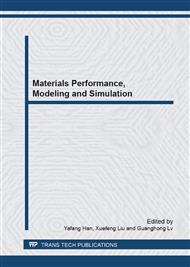[1]
Z.Y. Liu, N.H. Loh, S.B. Tora, K.A. Khora, Y. Murakoshi, R. Maeda, T. Shimizu, Micro-powder injection molding. J. Mater. Process. Technol. 127 (2002) 165-168.
DOI: 10.1016/s0924-0136(02)00119-x
Google Scholar
[2]
S.G. Li, G. Fu, Dimensional variation in production of high-aspect-ratio micro-pillars array by micro powder injection molding, Appl. Phys. A. 89 (2007) 721-728.
DOI: 10.1007/s00339-007-4150-2
Google Scholar
[3]
D.X. Li, B.Y. Huang, Theological properties of improved wax base binder, J. CENT. SOUTH UNIV. TECHNOL. 1 (2001) 70-73.
Google Scholar
[4]
V. Piotter, Injection molding of components for microsystems, Microsystem Technologies. 7 (2001) 99-102.
DOI: 10.1007/s005420100094
Google Scholar
[5]
Z.Y. Liu, N.H. Loh, S.B. Tor, Y. Murakoshi, R. Maeda, K.A. Khor, T. Shimidzu, Injection molding of 316L stainless steel microstructures, Microsystem Technologies. 9 (2003) 507-510.
DOI: 10.1007/s00542-003-0293-z
Google Scholar
[6]
E.S. Thian, Effects of debinding parameters on powder injection molded Ti-6Al-4V/HA composite parts, Advanced Powder Techno. 12 (2001) 361-370.
DOI: 10.1163/156855201750537901
Google Scholar
[7]
L. Liu, N.H. Loh, B.Y. Tay, S.B. Tor, Y. Murakoshic, R. Maedac, Micro powder injection molding: Sintering kinetics of microstructured components, Scripta Mater. 55 (2006) 1103-1106.
DOI: 10.1016/j.scriptamat.2006.08.039
Google Scholar
[8]
J.X. Gao, X.L. Zhou, X.H. Qu, New solvent debinding technology research of YT5 hard alloy, CEMENTED CARBIDE. 24 (2007) 153-157.
Google Scholar
[9]
L.Q. Zhen, K. Li, Investigation of catalytic debinding in Powder injection molding, POWDER METALLURGY INDUSTRY. 19 (2009) 32-35.
Google Scholar
[10]
X.J. Li, H.B. Lv, Powder injection molding binder and debinding technology research, P/M MS&E. 4 (1999) 207-212.
Google Scholar
[11]
B, Wu, MsD Thesis, Huazhong university of science and technology. (2005).
Google Scholar
[12]
J. h. Meng, N.H. Loh, Micro powder injection moulding of alumina micro-channel part, Journal of the European Ceramic Society. 31 (2011) 1049-1056.
DOI: 10.1016/j.jeurceramsoc.2010.11.034
Google Scholar
[13]
Y. Li, X.Q. Wang, The debinding process of wax-base binder in PIM, Materials, Science and Engineering of Powder Metallurgy. 16 (2011) 150-154.
Google Scholar
[14]
Y.J. Jie, Dissolution application manual, 3rd ed, Chemical industry press, Beijing, (2009).
Google Scholar
[15]
B.Y. Huang, X.H. Qu, X.L. Li, Debinding process of Fe-2Ni power, P/M MS&E. 5 (2000) 44-48.
Google Scholar
[16]
T.S. Chen, Chemical product in Forest and products, 1rd ed, Chemical industry press, Beijing, (1993).
Google Scholar
[17]
P.C. Yu, Q.F. Li, J.Y.H. Fuh, T. Li, L. Lu, Two-stage sintering of nano-sized yttria stabilized zirconia process by powder injection moulding, J. Mater. Process. Technol. 192 (2007) 312-318.
DOI: 10.1016/j.jmatprotec.2007.04.097
Google Scholar


